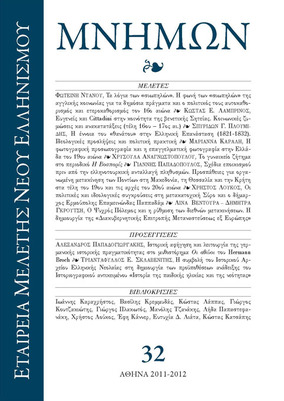Τέχνη καὶ ἰδεολογία. : Ὑποθέσεις σὲ δύο πίνακες τοῦ ζωγράφου Δευτερεύοντος Σίφνου (18ος-19ος αἰ.)
Part of : Μνήμων ; Vol.28, 2007, pages 91-167
Issue:
Pages:
91-167
Parallel Title:
Art and ideology : Assumptions on two paintings of defterevon Sifnou (18th-19th c.)
Section Title:
Articles
Author:
Abstract:
The paintings in question have been part of the Byzantine and ChristianMuseum’s collection since 1918 (figs. 1-2). The first painting (fig. 1) representsthe “Tale of Susanna” (Old Testament), the young Jewish girl who refusedto succumb to the lust of two aged judges, who then falsely accused her ofadultery. The other one (fig. 2) represents “Eros” sitting on a column accompaniedby two other persons, a woman (bottom right) and a man (bottom left).They are supposed to be in love with each other, and they are just about tobe devoured by dragons. Both panels were painted as a couple on “November7, 1825” by the priest Agapios (mid-18th c.-1829), the so-called “Defterevon(second priest in the rank) of Siphnos”. (Siphnos: the small Aegean island,where Agapios worked during most of his life).Using two different “languages”, the two paintings as a couple representa combined attack against human passion and carnal desire. Moreover, both ofthem but especially “Eros” represent an innovative (iconographic and stylistic)trend in Greek painting of the time, also evident in other works. Some of these works are similar (like those now in view) in their attitude against social tendencies,criticized as non-ethical or spiritually dangerous (figs. 5, 6).From the 1770’s onwards Greek Enlightenment has been celebrating therole of passion in human activity. During the same period, erotic literature inprose or in verse cultivated on the basis of Enlightenment’s standards, wasemerging and was gaining a numerous audience in the greater centers of theOttoman Empire. There is a manuscript of the beginning of the 19th c., nowin the Benaki Museum (figs. 7, 8), where erotic verses are combined with patrioticones indicating the passion or love for one’s country. An image of “Eros”,which is also contained in this manuscript (fig. 8), gives us the opportunity(when compared to Defterevon’s panel), to indicate that other representationalpossibilities of the passion of love, placing the emphasis on the positive ratherthan the negative aspects of this passion, were indeed present at the time.Although it is obvious both in written and iconographical sources that apart of the Greek Orthodox Church was very frustrated with such a positivetreatment of the passion of love (fig. 9), the pro-love tendency, going togetherwith some changes in political thought, left in the following decades its traces,obvious in the liberal spirit which came to contest the traditional spirit of theChurch. But the fact that Enlightenment was defeated within Greek societylong before 1825 does not permits us placing the two panels in the context ofthe general reactionary activity of the Church.So, the examination of the historical situation in the island of Siphnosaround 1825 proves inevitable in order to achieve a full estimation of themeaning of these two paintings. Many issues were at risk at the time whenGreek Revolution burst out (1821), driven forward by a huge economic crisis.The most prominent issue, which in a way incorporated all the others, was thestrife between old and new economic, political, and ideological powers in Greeksociety. This strife is also evident at Siphnos. The local aristocracy of the “oldregime”, without being explicitly “anti-revolutionary”, yet was very anxiousin its efforts to maintain at any cost the political status that was enjoying longbefore. On the other hand, the basic scope of the main revolutionary powers,i.e. the Greek bourgeoisie, was to give life to a new national and liberal countryin which the central authority of the state would (and should) overcome allprevious local and centrifugal authorities.Internal quarrels emerging on the island of Siphnos (mostly around 1823-1825) must be placed in the wider perspective of the revolutionary period’sGreek civil war. The leading actors of these local quarrels were from one sideNikolaos Chrysogelos, a mid-range scholar and native of Siphnos, who hadtook the initiative of the island’s revolutionary activity in 1821, and from theother side the famous Siphnian family of Baos with its allies, who was at the top of the island’s aristocracy long before 1821. In March 1825, immediatelyafter the end of the civil wars, Chrysogelos was officially denounce thepriest and Economic Administrator (Oikonomos) of the local Church, NikolaosBaos, that exercising his power beyond given authority at the period betweenOctober-December 1824 “he had divided married couples, he had marriedadulterers for money”.This specific episode, examined in detail in our study, leads us to concludethat (in strong possibility) Chrysogelos himself (or at least some people of hisentourage) commissioned the two paintings in order to prove “immoral” theformer local authorities and so to diminish their political influence in the island.In the light of these events, the position taken by the two works becomesclearer. Political relations between local aristocratic powers and Constantinopledo exist in the wide frame of a common-shared ideology, which one could becall “phanariotic”. This ideological frame includes also pro-love ideas, whichwas expressed through the phanariotic love-songs. According to some testimony,Nikolaos Baos’ father, Apostolos Baos, had had some knowledge on musicacquired in Constantinople, at the time when he had been a pupil of Petros ofPeloponnessos, a very famous versifier and composer of erotic songs.The point of the two panel’s suspension needs now an answer. In February1825, after a proposal made by Chrysogelos, the Revolutionary Governmentdecided to open again the School of the Holy Sepulcher in Siphnos, renamedas “Common Greek School”. In our view, both panels were to be suspended inthis building, which now was the most prominent civic building on the island,a symbol of the newly established powers and their ideological predominance.
Subject:
Subject (LC):




